Archive for the 'Africa' Category
For three weeks during the month of August 2019, I got the incredible opportunity to volunteer at the Limbe Wildlife Centre in Cameroon. The LWC initially was the Victoria Zoo until 1993 when a partnership was born between the Pandrillus Foundation and Cameroon’s Ministry of Forestry and Wildlife in an effort to protect the local biodiversity and raise awareness about conservation. The Victoria Zoo then became a wildlife center focused on wildlife rehabilitation and conservation education. The animals there were orphaned as a result of human-wildlife conflicts such as bushmeat hunting or the pet trade. These are major issues in Cameroon and throughout Africa. Animals are often killed both legally and illegally for meat in unsustainable ways, and the infants are kept as pets in unfit living conditions for wild species. When they are rescued by authorities and brought the LWC, the animals are treated by their veterinary team and the rehabilitation process starts as they are integrated into conspecific groups and monitored by their team of specialists. Their mission is based not only on rehabilitation and release, but on educating the population to change views and opinions on wildlife and conservation so that these animals will be safe in the wild for as long as possible.

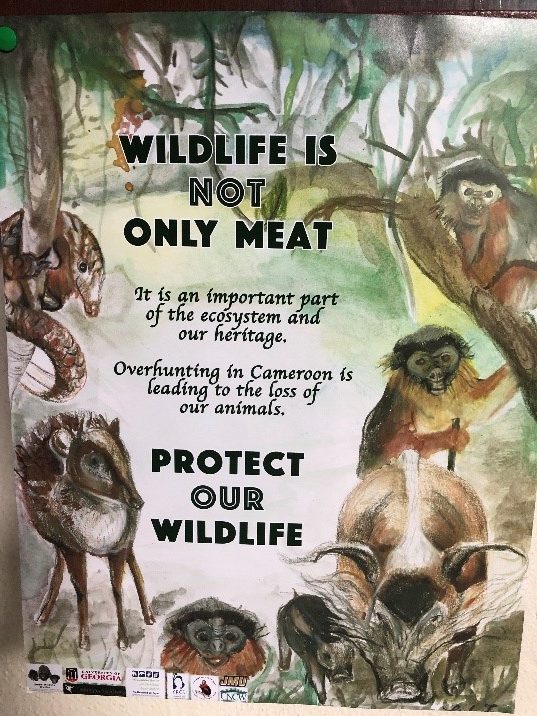
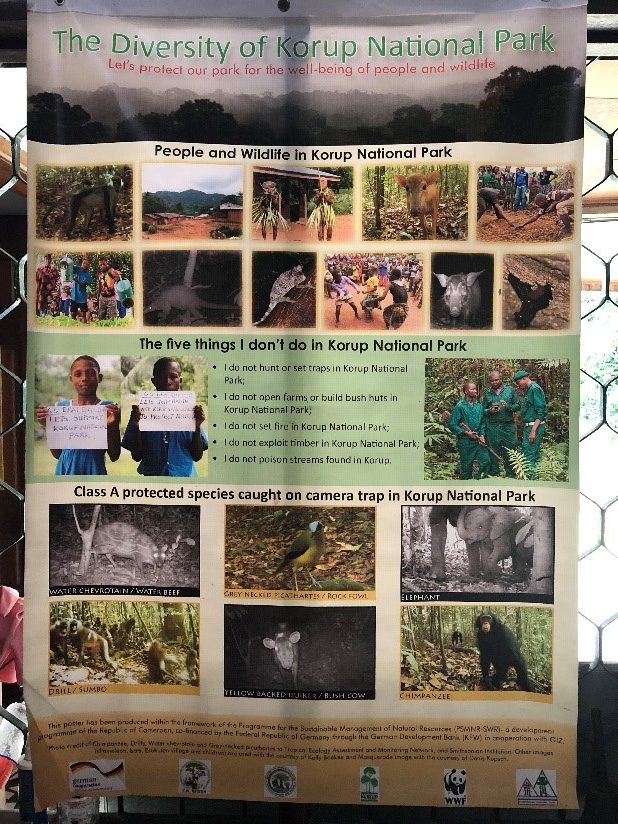
My job as a volunteer at the Centre was that of an assistant animal keeper. During my time there, I would get to assist keepers throughout the five different sections at the sanctuary: gorillas, chimpanzees, guenons and mangabeys, Papios (drills, mandrills, baboons), and quarantine. Mornings at the Centre would begin with friendly greetings, handshakes, and hugs shared with everyone nearby. Limbe is indeed the friendliest town I have ever visited.

Working giving enrichment as a volunteer; masks and gloves are very important to prevent the spreading of zoonotic diseases!
One of the Head Keepers, Jonathan or Victor would then begin the morning with a general team meeting to discuss important news, tasks for the day, and to assign sections to all keepers. Once assigned to a section, the morning consisted of feeding, providing browse, and cleaning the enclosures of all animals. This experience surely shows how each species has their own little quirks. Chimps are definitely the loudest (and debatably the messiest to clean after), the gorillas hate being stared at, and monkeys oftentimes just want to cause mischief by taking your supplies! This experience gave me an appreciation for the quirks among individuals in a species, but even more so for the distinct personality traits between individuals. We all eventually formed our opinions on favorites and developed closer bonds more with some animals than with others.




Once all of that was finished, volunteers were usually asked to help create enrichment for the day.
Enrichment is environmental stimuli (often nutritional and structural) designed to improve the wellbeing of sanctuary animals by keeping them mentally and physically engaged and stimulating natural behavior they would be doing in the wild. For enrichment, we often made “leaf packs” (snacks wrapped in leaves and twine that primates must unpack to eat), as well as re-used and washed plastic bottles filled with browse and other nutritional supplements, boxes, and other variations. Some days the chimpanzees (Pan troglodytes) are given sticks to remove honey from crevices on a termite mount, to practice their tool use, or are given ice blocks with treats to try to break and melt. The idea is to induce critical thinking and problem-solving. At noon, everyone at the Centre breaks for lunch. A local Cameroonian dish is served in the meeting hall every day for volunteers and staff. This varies daily but sticks to a few main ingredients: rice and beans are popular, fish (as Limbe is a fishing town), oils, spices, and a traditional African meal fufu was very common. Fufu has multiple variations depending on what it is made with, but it is basically a dough-like food used to fill stomachs when food is scarce. The Cameroonian lunches were not my favorite part of the experience, but I was so grateful for people to share with me their food and culture.

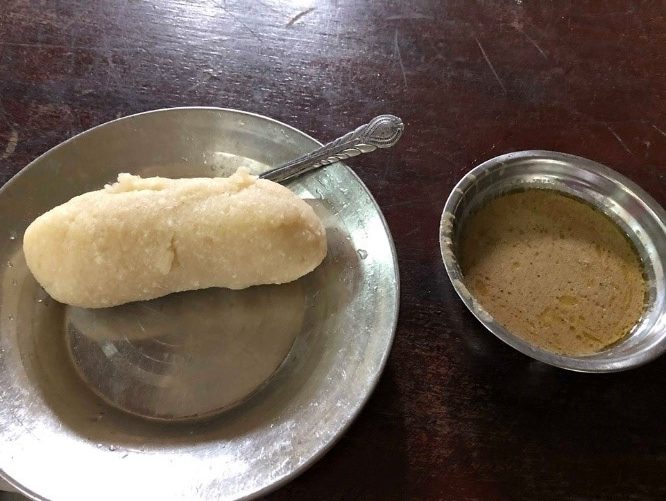
In the afternoons, keepers were tasked with observing their animals for monitoring, which freed up time for volunteers to work on maintenance projects around the Centre with the construction team. During the time I was there, the LWC was working on building a new rehabilitation aviary for the rescued African grey parrots (Psittacus erithacus) in their care. So, my afternoons mostly consisted of helping in construction and painting. Other options included harvesting browse for animals, preparing food, etc. At one point, I was even offered the opportunity to help with observations. The LWC is dedicated to being knowledgeable about the specific animals in their care and providing the best possible care, so I was able to watch a group of guenons consisting of two species, mona monkeys (Cercopithecus mona) and putty-nosed guenons (Cercopithecus nictitans), to try to problem-solve some social issues they were having. Close observation and research are the best ways to learn about animals to make adaptations to their environments or social groups for their benefit. This gave me practice for my future career in primate research and helped them prevent monkey injuries due to conflict. If you are a long-term volunteer with the LWC, you have the option to start your own research project based on the observation of animals in their care.



After work was always pleasant, returning to the volunteer house to shower, eat, and rest. Of course, it was different from my luxurious life in the US in almost every way. Shower water had to be warmed on the stove, and mosquito nets hung over the bed, but it truly brought one back to a simpler place in time.



Overall the work was hard and the days long but working at the sanctuary gave one a sense of pride in their work and a sense of meaning. Coming back to the house at the end of the night has a sense of camaraderie and belonging. All the little outside worries that exist in western society seemed to fade and no longer matter. With upbeat Cameroon music and delicious grilled chicken smell, and the extreme friendliness of locals in the air, it could truly make one rethink the meaning of home.
TotalAdventure does not currently have adventures in Cameroon, but we invite Cameroon companies to apply. TotalAdventure has some great trips to South Africa https://bit.ly/2WPNkPb
Lucky for me, my birthday fell within this trip to Cameroon. To celebrate, some of the sanctuary staff took me to Tsaben Beach. About a half hour from the town of Limbe, Tsaben Beach was the antithesis of polluted Down Beach. In fact, it is among the most beautiful beaches I have ever seen in my life. Black volcanic sand and rocks line the crystal blue water, and lush greenery is ever present. A row of pavilions provides a shady spot to down some beers and play cards.
Our visit took place during the rainy season in Cameroon, so tide was too high and rough to swim, and the sky was too cloudy to see the rumored breath-taking sunset. According to the locals, it was a flop of a beach day, but I think it was the most beautiful beach and best birthday I’ve ever experienced.










TotalAdventure does not currently have adventures in Cameroon, but we invite Cameroon companies to apply. TotalAdventure has some great trips to South Africa https://bit.ly/2WPNkPb
During our stay in Cameroon, we visited Bimbia, was the largest slave trade site in all central Africa. It was quite harrowing and eerie to be there. It felt as if the site was alive with the spirits of the hundreds tortured and murdered there. Among the atrocities we witnessed was a feeding trough where people’s hands and feet were chained together, and they were made to eat with their mouths, hunched over. We saw large pillars where people were chained on top of each other and left to struggle until one remained. The survivor was then sent through the “door of no return” onto a boat to a small island. The island had no food or water and was a holding site for slaves waiting to be taken to the Americas or Europe, sometimes in abundance of two weeks.
We also learned that many tribes people came to Bimbia thinking there was a prosperous life with jobs there because many of their friends and family were taken there and never returned. Once they crossed the bridge into Bimbia, they were kidnapped, chained, and enslaved. It was a very painful place to witness firsthand, but certainly a worthwhile experience for anyone visiting central Africa.










The site holds reenactments annually that involve rebuilding some areas of the site.





TotalAdventure does not currently . have adventures in Cameroon, but we invite Cameroon companies to apply. For another exotic area in Africa, check out our trip to Ethiopia. https://totaladventure.travel/trips/203383
A glimpse of Douala
I arrived at Douala airport (one of the two biggest cities in Cameroon) late in the evening August 10th, 2019. I was warned before arriving that I would very quickly and easily make friends. This was lucky for me because the very first person I met on the airplane was crucial to my making it safely to my destination. In Cameroon, people tend to be very kind and inviting. Perfect strangers helped me fill out paperwork, navigate the airport and safely find my driver.
Once I was in the car, the ride to the volunteer house was about an hour and a half. The city of Douala was such a culture shock- it was almost indescribable. Unfortunately, it was after midnight, so I could not see much, but what I did see was SO different. The city was nothing like my experience of a US city. The infrastructure from roads to buildings were seemingly dilapidated and old. Many markets and shops were simple tents or just products (like bed frames) laying on the side of the street.
Yet, much of the city was still very much awake at 1AM. There were clubs and bars full of people and loud music. The most mouthwatering smell of grilling chicken permeated the air everywhere we went.
Older cars and bikes were driving all over the road in a strictly Cameroonian way of driving. The traffic was another major culture shock. Laws that would be enforced in the US seemed more like suggestions here. Red lights don’t necessarily mean stop- they mean look before you go. Many roads were not divided into lanes, and the ones that were were completely ignored. Cars weaves around each other sometimes squeezing four side by side. Bikes, pedestrians, and cars shared the road equally.
Perhaps the scariest part is when we were stopped at two roadblocks- one leaving Douala and one entering Limbe- by police. They just wanted to check our identification, but they were holding very threatening machine guns and were not very friendly. The stretch between the cities was very natural and forested, but too dark to see anything.
Limbe
I woke up to the sounds of an animal orchestra outside of the research house. Combined with the sounds of all the primate species at Limbe wildlife center were the screeches of all the neighborhood chickens, cats, dogs, pigs, horses, and other unidentified animals.

Limbe wildlife center is a major attraction of Limbe and the reason why I am here. The LWC is a wildlife education and conservation center. The animals kept here were orphaned as a result of bushmeat hunting or the pet trade. This is a huge issue in Cameroon and throughout Africa. Animals are often killed for meat, and the infants are kept as pets or trophies in horrible living conditions. They are rescued and brought the LWC for rehabilitation and to live with members of their own species. I am lucky enough to be spending 3 weeks volunteering at this sanctuary.

One of my first stops in Limbe was the local market “old market”. The most efficient way to get there is by motorbike. This was a totally new experience to me- clinging to the back of a bike in weaving traffic. The market was much like stores in Douala where tents or small wooden shelters cover the fruits and vegetables spread on burlap sacks on the ground. There were probably 20 or so shops at the market with a wide variety of African produce. Many merchants will help you find what you’re looking for, and you’re almost guaranteed to go home with a free sample of some new or unique produce.

Just a few blocks from the market is mars bar- a European themed restaurant and bar on Down Beach. Down beach is a black sand beach that stretches along the coast of Limbe. It is not very good for swimming because of the amount of litter, but it is popular for the fishing culture and economy of Limbe. The beautiful Mountain View and the sunset over the ocean also make it well worth the visit.



Finally, another worthwhile attraction is the Limbe botanical garden. The garden is home to many beautiful (and some edible) plants. There is also a “naturalistic” amphitheater, a nearly 200-year-old cemetery, and plenty of beautiful views. While you are there, be sure to check out Hot Spot, a restaurant within the garden that has delicious burgers, and sometimes even cheeseburgers- which are extremely rare in Limbe.


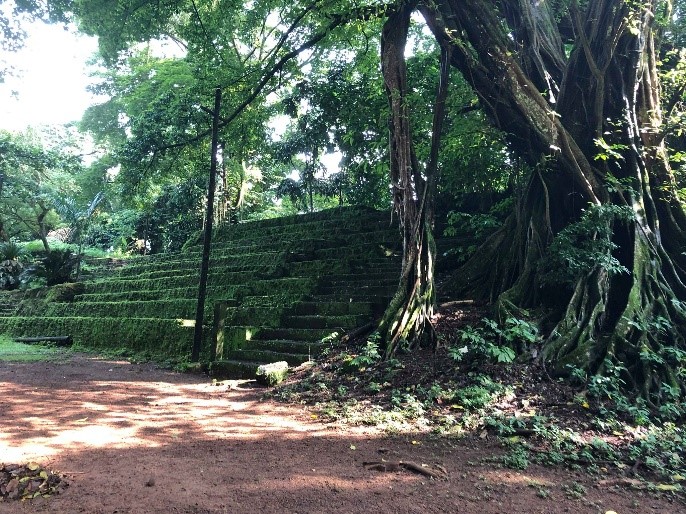
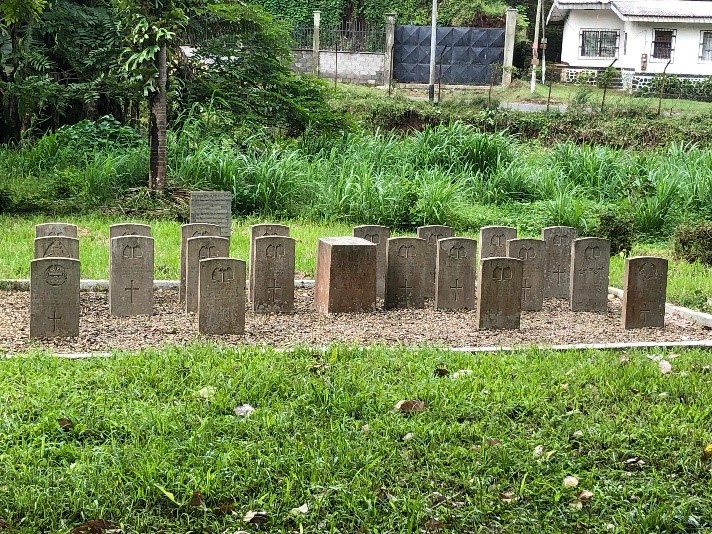
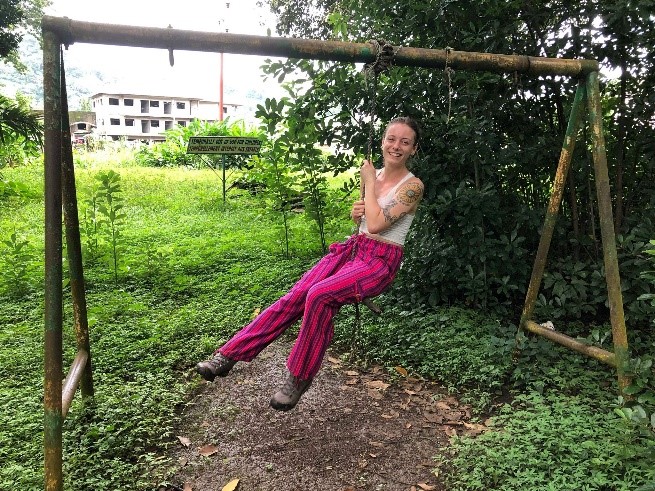
Overall, the breathtaking nature, incredibly sweet and welcoming people, and the laid-back lifestyle of Limbe made it one of my all-time favorite destinations.
TotalAdventure does not currently . have adventures in Cameroon, but we invite Cameroon companies to apply. For another exotic area in Africa, check out our trip to Ethiopia. https://totaladventure.travel/trips/203383
In the summer of 2019, I was offered the amazing opportunity to volunteer at a Cameroonian primate sanctuary as an animal care giver. During one of my days off from the sanctuary, a fellow volunteer (Tesse) and I took a tour with local guide Thompy Ekonde. He showed us around “Mangrove Forest” just outside of Bimbia. The road there was long, winding, and treacherous with huge rocks, ditches, and falling logs. Many times we had to pull over to calculate exactly how to place the car. Upon arriving at the forest, we trekked through the trees for about two hours as Thompy showed us some of the breathtaking native African flora.

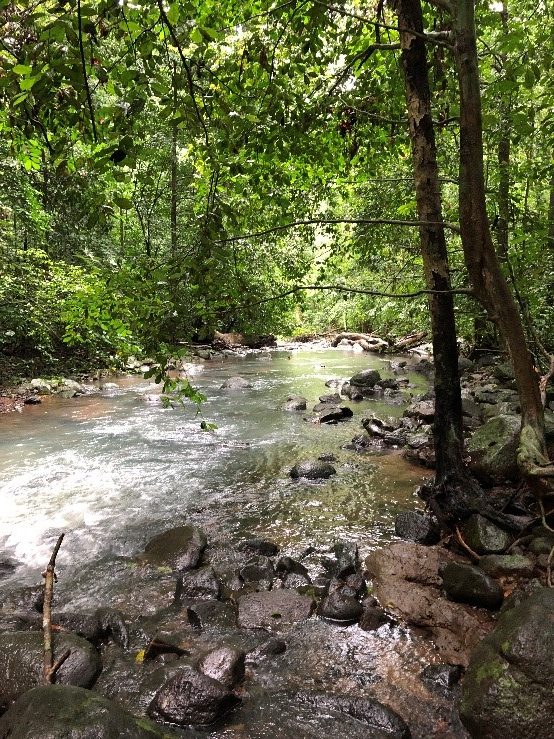
We had to wade through two shallow but powerful rivers cutting through the lush forest.
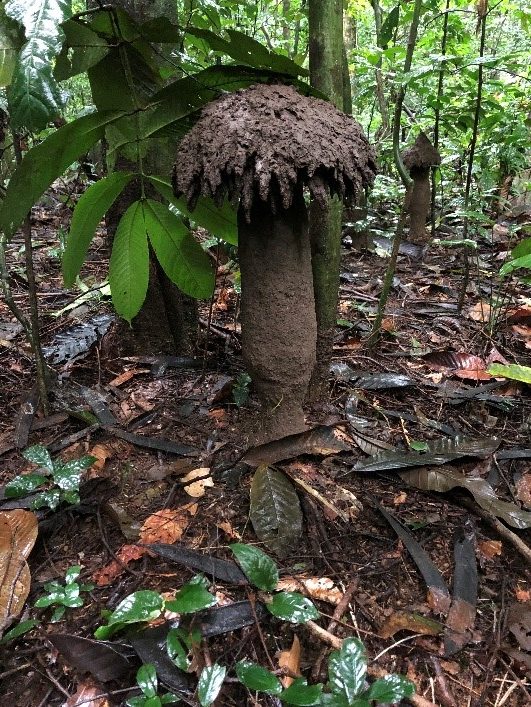
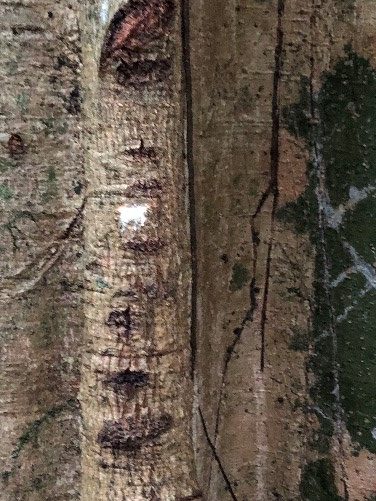
This tree is called the “milk tree” by locals. It is used in Cameroon as a medicine, the bark and white sap underneath are harvested and made into a drink for breast feeding mothers. The drink is said to increase the amount of breast milk produced, in a country where it is culturally significant to have many kids.
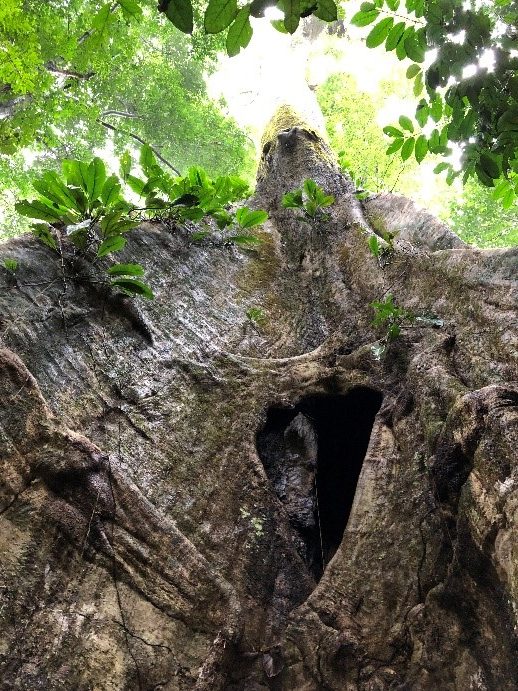
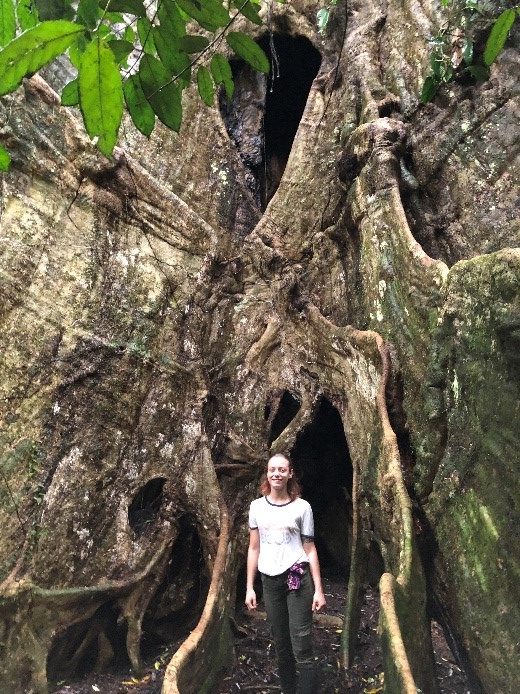
This tree pictured is the largest and oldest tree in the forest at over 400 years old, and too tall to see through the forest canopy.

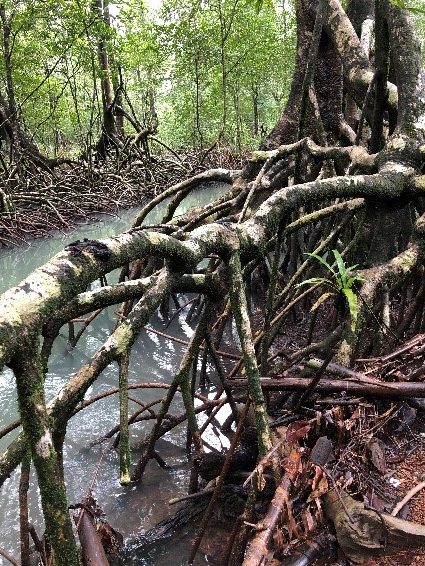
This is a small section of the acres of mangrove forest. During our visit, it was low tide and was very easy to see the magnificent system of roots tying this forest together.
TotalAdventure does not currently . have adventures in Cameroon, but we invite Cameroon companies to apply. For another exotic area in Africa, check out our trip to Ethiopia. https://totaladventure.travel/trips/203383
A quick representation of destinations since the GoPro was acquired less than a year ago. Featured : USA,Mongolia,South Africa,Namibia,China. Music will now accompany most videos.
One week in Namibia barely scratches the surface. ArcticTropic was there in October, 2013 for the Adventure Travel Trade Association annual conferences in the capital city of Windhoek and the small seaside city of Swakopmund. At least weeks is needed to see the country properly.
For adventures in Namibia, CLICK HERE
After Namibia , ArcticTropic had less than a week to explore the vast territory of South Africa. 3 days in Cape Town was plenty, but the 1000 mile,1600 km journey back to Johannesburg via the Wynlands,the Great Karoo and the South Coast was quite a feat, meaning many hours in the car.
For adventures in South Africa, CLICK HERE
A Saturday afternoon journey from Muizenberg to Fish Hoek near where the Atlantic meets the Indian Ocean. A preacher man works the aisle. The train is much like the NYC subway, but with better scenery. Cost is 6 Rand or 60 cents US.
For adventures in South Africa, CLICK HERE
On a hot spring afternoon in Namib Naukluft Park, ArcticTropic and fellow adventurer travel companies embarked on a horse safari covering many kilometers in the desert. THe trip was organized by Chameleon Holidays Travel in conjunction with the ATTA Summit. An edited version of this adventure is soon to follow – this is raw footage.
For adventures in Namibia, CLICK HERE

